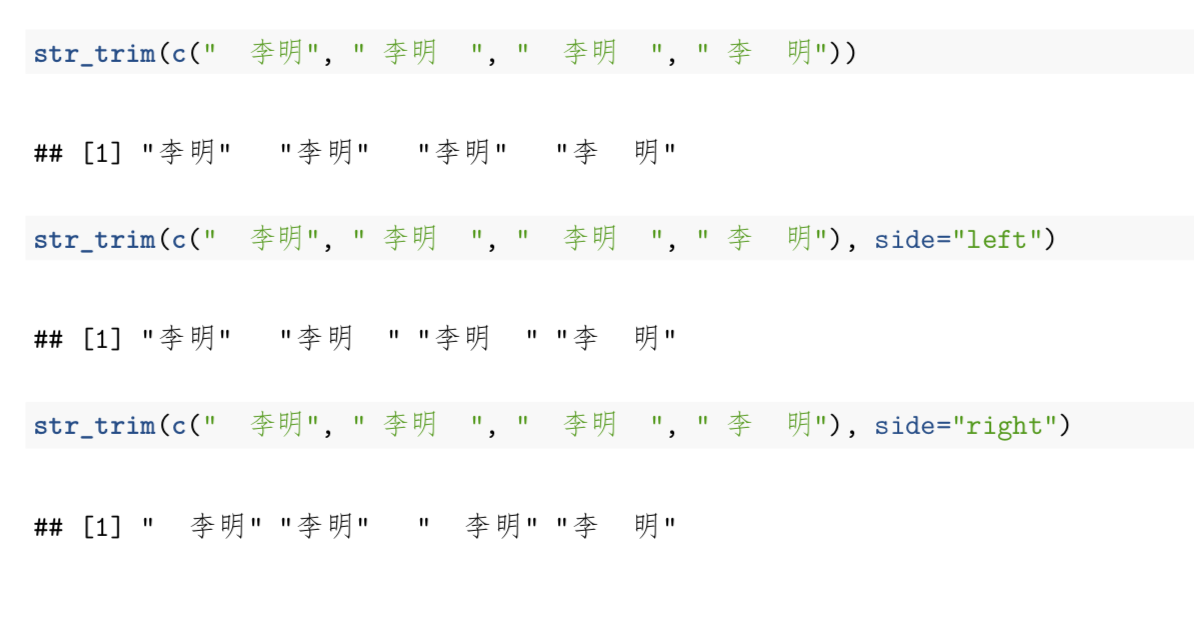基本用法
查看长度
x <- "The birch canoe slid on the smooth planks."length(x)str_length(x)> length(x)[1] 1> str_length(x)[1] 42
length 只会返回出x 中的元素数(长度为1 的字符串类型的向量)。
str_length 才会返回字符串长度。
拆分与组合
拆分
需要注意的是,提取拆分后的元素需要使用 [[]] 双括号选择。
x <- "The birch canoe slid on the smooth planks."str_split(x," ")x2 = str_split(x," ")[[1]]# 此时x2 是一个包含x中所有单词(用空格拆分了)的向量。> length(x2)[1] 8
合并
collapse 设定合并向量中内容使用的分隔符。
str_c(x2,collapse = " ")
collapse 参数设定分离的元素结合成一个字符串分离的符号。
还可以将两个向量中的元素,或向量和另外一个字符串进行合并。
str_c(x2,1234,sep = "+")
sep 参数设定某两个分隔的元素连接,使用某符号。、
如果是长度不相等的两个向量合并,则会循环连接(挨个对上,而非全部对上):
> c[1] 9 10 1 8 4 5 6 2 12 11 7 3> b[1] "a" "ppple"> str_c(c,b, sep='+')[1] "9+a" "10+ppple" "1+a" "8+ppple" "4+a" "5+ppple"[7] "6+a" "2+ppple" "12+a" "11+ppple" "7+a" "3+ppple"
提取字符串
str_sub(string, start = 1L, end = -1L) ,从start 到end, 为提取的string 中字符在字符串中的位置。(空格也占位!)
x <- "The birch canoe slid on the smooth planks."str_sub(x,5,9)
大小写转换
upper 大写,lower 大写,title 首字母大写。
str_to_upper(x2)str_to_lower(x2)str_to_title(x2)
字符串排序
默认按照英文字母或数字大小顺序。
str_sort(x2)
空白处理
stringr::str_trim(string, side) 返回删去字符型向量 string 每个元素的首尾空格的结果,可以用 side 指定删除首尾空格(“both”)、开头空格(“left”)、末尾空格(“right”)。如:

stringr::str_squish(string) 对字符型向量 string 每个元素,将重复空格变成单个,返回变换后的结果。
高级用法
字符检测
对字符串分隔后的向量与待检测的字符进行比较,生成等长的逻辑值向量。
detect 检测全字符,starts 检测首字母,ends 检测末字母。
str_detect(x2,"h")str_starts(x2,"T")str_ends(x2,"e")> str_detect(x2,"h")[1] TRUE TRUE FALSE FALSE FALSE TRUE TRUE FALSE
还可以联合 table 统计TRUE 与FALSE 的数目。
> table(str_detect(x2,"h"))FALSE TRUE4 4
另外,也可以联合 sum 获取TRUE 数目, mean 获得TRUE 比例。
> sum(str_detect(x2,"h"))[1] 4> mean(str_detect(x2,"h"))[1] 0.5
提取匹配字符
将向量中符合要求的元素提取为一个新的向量。
> x <- str_subset(x2,"h")> x[1] "The" "birch" "the" "smooth"
ps:匹配和检测支持正则:

字符计数
计算字符串内指定字符出现次数。
str_count(x," ")str_count(x2,"o")> str_count(x," ")[1] 7> str_count(x2,"o")[1] 0 0 1 0 1 0 2 0
字符替换与删除
replace 会替换字符串中指定的第一个字符。
而replace_all 则替换全部符合的字符。
str_replace(x2,"o","A")str_replace_all(x2,"o","A")> str_replace(x2,"o","A")[1] "The" "birch" "canAe" "slid" "An" "the"[7] "smAoth" "planks."> str_replace_all(x2,"o","A")[1] "The" "birch" "canAe" "slid" "An" "the"[7] "smAAth" "planks."> > str_remove(x2, "[.]")[1] "The" "birch" "canoe" "slid" "on" "the"[7] "smooth" "planks"
str_remove 可以将指定的某个字符串从字符串中删除。
练习题
6-2
#练习6-2library(stringr)#Bioinformatics is a new subject of genetic data collection,analysis and dissemination to the research community.tmp <- "Bioinformatics is a new subject of genetic data collection,analysis and dissemination to the research community."#1.将上面这句话作为一个长字符串,赋值给tmp#2.拆分为一个由单词组成的向量,赋值给tmp2(注意标点符号)tmp2 <- tmp %>%str_replace(',', ' ') %>%str_replace('\\.','') %>%str_split(" ")# 直接用或连字符, str_split(" |,") 可以省去替换, 操作tmp2 <- tmp2[[1]]tmp2#3.用函数返回这句话中有多少个单词。length(tmp2)#4.用函数返回这句话中每个单词由多少个字母组成。str_length(tmp2)#5.统计tmp2有多少个单词中含有字母"e"sum(str_detect(tmp2, "e"))

